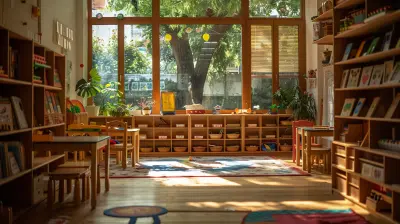12 April 2025
As educators, we’re always looking for ways to make learning more engaging and meaningful for our students. One of the most effective ways to do this is by integrating cross-curricular skills into your daily teaching. It’s like blending the ingredients of a recipe; when done right, the result is a rich learning experience that students can savor—and more importantly, benefit from.
But what exactly are cross-curricular skills? Why should you incorporate them, and how can you fit them into an already jam-packed curriculum? Well, let's dive into it!

What Are Cross-Curricular Skills?
Cross-curricular skills are competencies that transcend a single subject. These are the skills that students can apply across different areas of learning and, more importantly, in their everyday lives. Think problem-solving, critical thinking, collaboration, creativity, and communication.Imagine teaching science while incorporating literacy skills, or using math to enhance students' understanding of history. When these connections are made, students are able to see the bigger picture rather than compartmentalizing knowledge into isolated subjects.
Some core cross-curricular skills include:
- Critical thinking and problem-solving
- Collaboration and teamwork
- Communication (both written and verbal)
- Digital literacy
- Creativity and innovation
- Research and inquiry skills
These are not just “nice-to-haves” but must-haves in today’s world. In fact, many of these skills are what employers are looking for in the workforce. So, by integrating these into your daily teaching, you're equipping your students with tools that will serve them throughout their lives.

Why Integrate Cross-Curricular Skills?
Okay, so now that we know what cross-curricular skills are, why should we care about them? Why not just focus on our specific subject areas and call it a day?1. Real-World Application
Life doesn’t happen in silos, and neither should learning. When students go out into the world, they won’t solve problems with just math or just history—they'll need to pull from various skills and knowledge areas to navigate challenges. Integrating cross-curricular skills helps students see the relevance of what they’re learning and how it applies to real-world situations.2. Engagement Boost
Let’s face it—students often ask, “When will I ever need this?” By connecting different subjects and skills, you’re showing them that everything they’re learning is part of a bigger, interconnected picture. This can spark curiosity and engagement, making lessons more enjoyable and meaningful.3. Fosters Critical Thinking
Cross-curricular teaching encourages students to think critically. For example, when students analyze a historical event through the lens of science or economics, they're required to think about the topic in a more complex and layered way. It challenges their assumptions and pushes them to dig deeper.4. Prepares Students for the Future
In a world that’s constantly evolving, it’s essential that students are versatile learners. Cross-curricular skills prepare students to tackle complex, multifaceted problems, which is what they’ll encounter in the workforce. These are the skills employers are begging for: adaptability, critical thinking, and collaboration.
How to Integrate Cross-Curricular Skills into Your Teaching
So, how do you actually go about integrating these skills into your teaching without overwhelming yourself—or your students?1. Start Small
If the idea of cross-curricular teaching seems overwhelming, don’t worry—you don’t have to overhaul your entire curriculum in one go. Start small by looking at your current lesson plans and identifying opportunities to weave in cross-curricular skills. Could you include a writing component in your science lesson? Or introduce a collaborative project in your math class? Small changes can make a big difference.2. Make Connections Between Subjects
Look for natural connections between subjects. For example, if you’re teaching a history lesson about the Industrial Revolution, you could incorporate math by having students analyze data on production rates. Or, in an English class, you could discuss the scientific discoveries of a famous author’s time and how they might have influenced their work. The goal is to help students see that knowledge is interconnected.3. Collaborate with Other Teachers
Teaching doesn’t have to be a solo sport. Collaborate with your colleagues to create projects that span across multiple subjects. For example, you and the science teacher could team up to create a project that requires students to write a research paper (English) about a scientific topic (science) and then calculate data or create graphs (math) to support their findings.4. Use Real-World Problems
One of the best ways to integrate cross-curricular skills is through problem-based learning (PBL). Present students with a real-world problem that requires them to use skills from multiple disciplines to solve. For example, you could ask students to develop a plan to reduce the school’s carbon footprint. This would require them to use science (environmental studies), math (data analysis), and even communication (presenting their findings).5. Incorporate Technology
In today’s digital age, tech literacy is an essential cross-curricular skill. Whether your students are using Google Docs to collaborate on a project, creating a presentation in PowerPoint, or conducting research online, integrating technology can help them develop critical digital skills that will serve them in any field.
Examples of Cross-Curricular Activities
Now that we’ve covered the “why” and “how” of cross-curricular teaching, let’s get into some specific examples of activities you can try in your classroom.1. STEM Meets Art: Building Bridges
In this project, students research famous bridges (history and engineering), then sketch and design their own bridges (art), and finally use math to calculate how much weight their bridge could hold. This is a fun, hands-on way to integrate science, technology, engineering, math, and art, all in one project.2. Math in the Kitchen
Cooking is a fantastic way to teach math! Students can follow a recipe, scaling it up or down to feed a certain number of people. They’ll need to use fractions, multiplication, and division—all while learning an essential life skill.3. History and Language Arts: Letters from the Past
In this activity, students pick a historical figure and write a series of letters as if they were that person. This combines history (researching the figure) with language arts (writing the letters), while also helping students practice empathy by putting themselves in someone else’s shoes.4. Environmental Science and Economics: The Cost of Going Green
Students research different ways to make the school more eco-friendly (science) and then calculate the economic impact of implementing those ideas (math and economics). They can present their findings to the class or even the school board (communication).Overcoming Challenges in Cross-Curricular Teaching
While integrating cross-curricular skills can be incredibly rewarding, it's not without its challenges. But don’t worry—there are ways to overcome them.1. Time Constraints
One of the biggest hurdles teachers face is the lack of time. With the pressure to cover specific content standards, finding time to incorporate cross-curricular skills can be tough. The key here is to start small—look for simple ways to integrate skills into your existing lessons rather than creating entirely new projects from scratch.2. Assessment
How do you assess cross-curricular skills when you’re used to grading based on subject-specific knowledge? One approach is to use rubrics that focus on the skills you want students to develop, such as collaboration, critical thinking, or communication. Make it clear to students that these skills are just as important as the content knowledge.3. Finding Balance
It can be tempting to try and integrate too many subjects at once, but this can lead to confusion for students (and for you!). The key is balance—focus on one or two cross-curricular skills at a time, and make sure they’re relevant to the lesson at hand.Conclusion
Integrating cross-curricular skills into your daily teaching is not just a trend—it’s essential for preparing students for the complexities of the real world. By weaving together subjects and skills, you’re helping students see the bigger picture, fostering critical thinking, and making learning more engaging and meaningful. And while it may take some time and creativity to get started, the benefits for your students are well worth the effort.So, ready to give it a try? Start small, collaborate, and watch your students thrive as they build the skills they need for life beyond the classroom!




Journey Matthews
Empower your students by weaving cross-curricular skills into everyday lessons! This approach fosters creativity, critical thinking, and real-world applications, preparing them to thrive in an interconnected world. Let’s ignite their potential!
April 15, 2025 at 12:27 PM